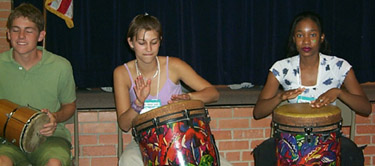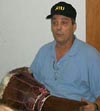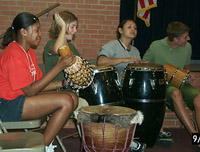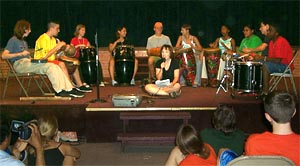The Dallas 'Gifted Magnet' Arts Retreat
review by Eric Stuer
 (Click
on the images for bigger versions) (Click
on the images for bigger versions)
The magnet high school for Gifted/Exceptional students
here in Dallas has a yearly 3 day retreat at a camp south of town.
The kids break up into groups of 12, including a teacher, and study
the various aspects of their theme for that year, then they get
together and give presentations to the student body, showing what
they've learned.
This year (September 6-8, 2001) the theme was based
on how different cultures express themselves through various arts
disciplines. Among other things, they looked at architchture, drama,
jewelry making... and drumming. I was honored to be invited by Dr.
Rebecca Jensen to help with the drumming group.
 I
only aided them in the initial stages, at the beginning of the
first day. I was to bring them some drums, discuss universal principles
of drumming, notably the ones common to all cultures, and
spend a couple of hours helping them brain storm for hands on possibilities.
Then it was entirely up to them and their teacher to form a presentation
over the next two days. I
only aided them in the initial stages, at the beginning of the
first day. I was to bring them some drums, discuss universal principles
of drumming, notably the ones common to all cultures, and
spend a couple of hours helping them brain storm for hands on possibilities.
Then it was entirely up to them and their teacher to form a presentation
over the next two days.
I brought them a big batch of instruments from various
cultures, including tamborine, pandeiro, kanjira, doumbek, djembe,
dhol, conga, cuica, cajon, etc.
The rain was pouring down that day, September 6,
so we used more Mylar heads than we would have otherwise. Instead
of a djun djun, we used a big 18" floor tom with a bell on
a stand..To my delight, the kids leapt into it, every one of them
ready to go. They learned very quickly.
 We
touched briefly on the origins and characteristics of the instruments
and talked about universal musical principles before sitting down
in a circle and beginning to play. We
touched briefly on the origins and characteristics of the instruments
and talked about universal musical principles before sitting down
in a circle and beginning to play.
 We
had to adapt quickly. With only 2 hours to get the whole thing rolling,
there was little time to focus on the many differences between congas,
ashikos, the REMO asongas, the djembe.. We worked with two basic
sounds from these drums: bass and tone, Gun amd Go. Once again,
the beginner rhythms taught to me by Baba Olatunji in his 3 day
workshop proved to be great starter material. Thanks Baba O. We
let the djembe play the calls, and put congas and asongas on these
two rhythms repectively: We
had to adapt quickly. With only 2 hours to get the whole thing rolling,
there was little time to focus on the many differences between congas,
ashikos, the REMO asongas, the djembe.. We worked with two basic
sounds from these drums: bass and tone, Gun amd Go. Once again,
the beginner rhythms taught to me by Baba Olatunji in his 3 day
workshop proved to be great starter material. Thanks Baba O. We
let the djembe play the calls, and put congas and asongas on these
two rhythms repectively:
(G=Gun, g,d=go,do)
1.
G.gd..G.gd..
2.
G.gdgdG.....
Tamborines and shekere joined together to simply play
the pulse..their cutting power made them naturals for the task.
Luckily, the students playing these instruments had a strong sense
of time, so it became easier for all. The kids quickly learned to
rumble at many dynamic levels, start and end and rumble on call,
play several basic rhythms and switch from one to another, and do
a little call and response. We ran through the possible techniques
10 or 12 more times, the bell rang, and my part was done. Now it
was up to them to choose their instruments and plan their presentation.
Back to town I went, leaving the instruments behind.
 Stage
2 - the practice - I went back to Dallas. Dr. Jensen had taken
good notes and listened well, and we passed the task of leading
the group, playing the calls and so on, from me to her. There were
three more practice sessions, each the length of the first, about
two hours, and during this time, they planned and executed what
they wanted to show in the final presentation. I'm still learning
more from Dr. Jensen about the way they arrived at it, but suffice
it to say that the team proved up to the task. Stage
2 - the practice - I went back to Dallas. Dr. Jensen had taken
good notes and listened well, and we passed the task of leading
the group, playing the calls and so on, from me to her. There were
three more practice sessions, each the length of the first, about
two hours, and during this time, they planned and executed what
they wanted to show in the final presentation. I'm still learning
more from Dr. Jensen about the way they arrived at it, but suffice
it to say that the team proved up to the task.
Stage 3 - The presentation - I learned afterwards
that the presentation had gone well. The event was a success. A
video was made of it, and perhaps we'll get a version up here soon..Click
on this presentation shot below for a better view.

My heartfelt thanks go to Dr. Jensen, to the faculty
and staff at the Dallas Magnet High School for Gifted and Exceptional
Students, and hats off to the kids in the drumming group for
their resourceful and energetic attitudes. I had a wonderful time,
and was very proud of the job they all did, especially given the
time restrictions.
|

